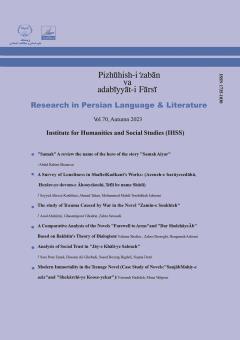In this paper, the influence of One Hundred Years of Solitude by Gabriel García Márquez on Touba and the Meaning of Night by Shahrnush Parsipur is discussed through a comparative-critical approach. In these two novels, confrontation and conflict between tradition and mo
More
In this paper, the influence of One Hundred Years of Solitude by Gabriel García Márquez on Touba and the Meaning of Night by Shahrnush Parsipur is discussed through a comparative-critical approach. In these two novels, confrontation and conflict between tradition and modernity is one of the most significant themes. So, this paper tries to depict the discursive and inter-textual connection between the above mentioned novels based on their similar content and themes. It also aims at demonstrating the way these two work confront the modern world based on the voices in the novels, explaining how the authors of these two novels, had a dialogue with modern world through a fusion of reality and illusion, physical and metaphysical world; and death and life. After a comparative study, this paper aims at revealing different aspects in these two novels regarding the discourse of tradition and modernity, according to a critical approach. It will be revealed how Parsipur’s narration suffers from the lack of integrity and coherence, in a way that “Touba and the meaning of night” doesn’t have the same firmness and complexity of One Hundred Years of Solitude. As a result, it couldn’t make proper use of elements like irony, credibility of characters and significant correlation of the events. In One Hundred Years of Solitude, the reaction to the foreigners is evidently critical, explicit, and contradictory. While, in Touba and the Meaning of Night, this reaction is chaotic, confused and somehow passive
Manuscript profile


